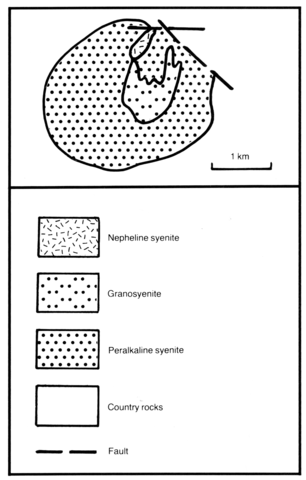stripes
The Akitskii occurrence of 4.5 km2 cuts Lower Palaeozoic granites and granosyenites. Arkhangelskaya (1974) determined the order of intrusion as peralkaline trachytic syenite, peralkaline aegirine granite and granosyenite and finally nepheline syenite. The peralkaline trachytic syenites are the most abundant rocks and are grey, leucocratic rocks of 75-90% microcline and aegirine-augite on which amphibole and biotite are developed; accessories include apatite, ilmenite and schorlomite. The peralkaline granites and granosyenites are fine-grained porphyritic rocks of a pinkish-grey. They comprise microcline perthite submerged in a groundmass of albite with quartz (10-20%) and aegirine; accessories are titanite, apatite, zircon and schorlomite. Nepheline syenites consist of microcline-perthite (35-70%) and nepheline (15-20%) in a fine-grained groundmass containing cancrinite, aegirine, arfvedsonite, biotite, titanite, apatite and ilmenite. The nepheline syenites contain partially resorbed remnants of the peralkaline syenites and granites. Five stages of post-magmatic mineralization are distinguished by Arkhangelskaya (1974): (1) microclinization, (2) albitization and aegirinization with the formation of albite-aegirine metasomites, (3) a fluorine-carbonate stage involving development of ankerite, calcite, fluorite and rare-earth fluorine-carbonate minerals, (4) the formation of lithium-bearing minerals including zinnwaldite and taeniolte, and (5) a hypergene stage involving crystallization of cerussite, smithsonite, hematite and hydroxides of iron and manganese. Post-magmatic rocks form approximately north-south-trending zones which are up to 10 m wide and 400 m long. Two of them lie inside the complex and are enriched in rare minerals: others are located in the country rocks and these are poor in rare minerals. The rocks of these zones are composed of microcline and albite with xenotime, taeniolite and pyrite. In the central parts of these zones small (up to 2 m diameter) nests of oligoclase with fluorite and ankerite and a number of rare minerals occur, the most typical being parisite, xenotime, taeniolite, fluorite, ankerite and baryte.
ANDRE’E V, G.V. 1981. Petrology of the association of the potassium, nepheline and peralkaline syenites. Nauka, Novosibirsk, 85 pp.
ARKHANGELSKAYA, V.V. 1974. Rare-metal alkaline complexes of the southern margin of the Siberian platform. Nedra, Moscow, 128 pp.
SEMENOV, E.I., ESKOVA, E.M., KAPUSTIN, Yu.L. and HOMYAKOV, A.P. 1974. The mineralogy of the alkaline massifs and their deposits. Nauka, Moscow. 248 pp.

